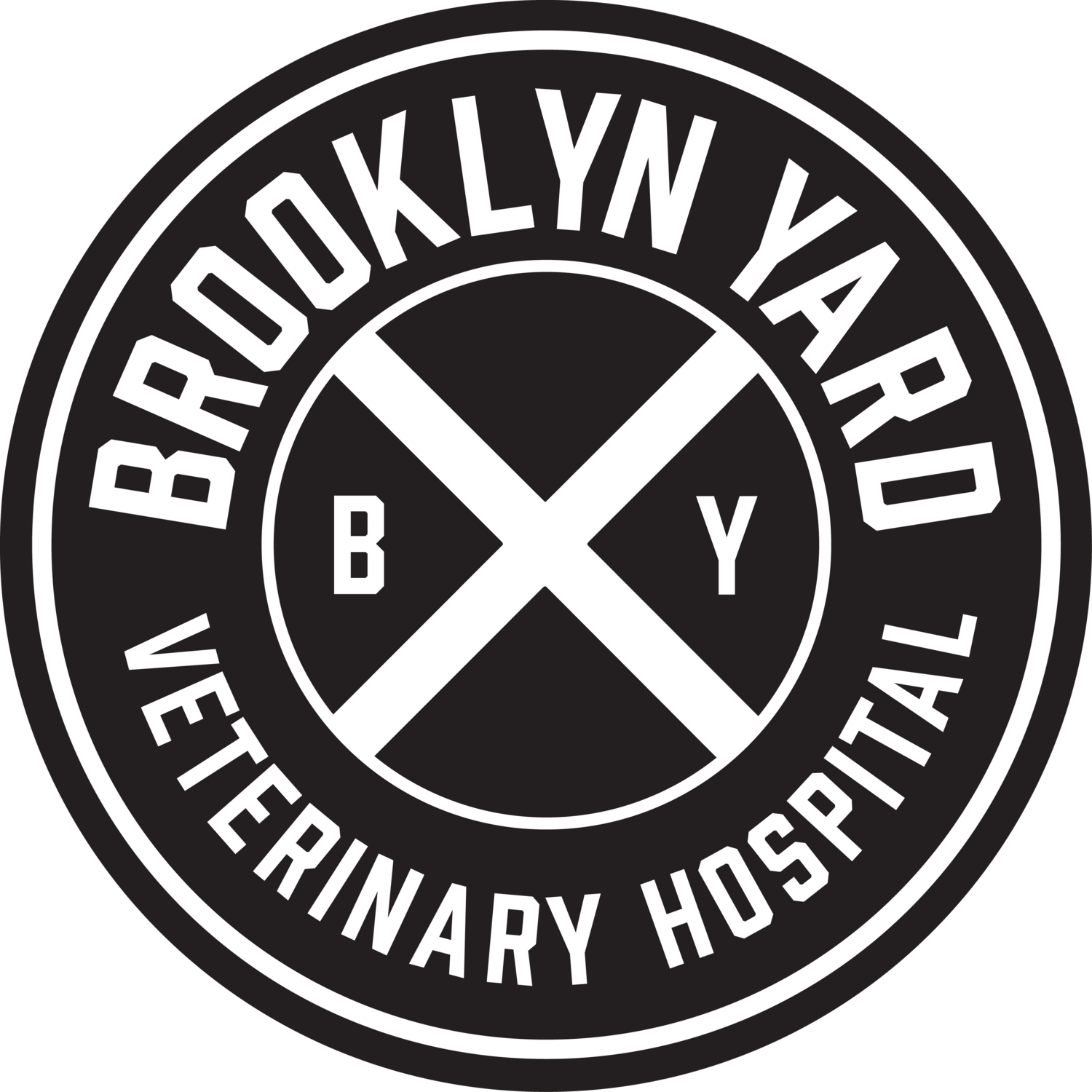
How do sedated examinations for patients with veterinary phobias and/or handling sensitive happen at Brooklyn Yard Veterinary Hospital?
We recognize that some of our patients have differing levels of comfort with people who they do not know entering their space in a novel setting (like a veterinary hospital). In some cases, a thorough physical examination or administration of vaccinations or other treatments may not be possible without complete sedation or after failure of oral pharmaceutical trials prior to an exam.
In cases where a physical examination is difficult to accomplish for a patient because of anxiety associated with veterinary visits/handling, a client and pet would first need to be established at our hospital in person. This involves making an establishing care appointment and paying a scheduling fee (applied to the initial exam). Please note that we are not able to prescribe any medication for your pet prior to this exam.
What happens at the initial exam?
In most cases, these first visits involve NO handling or contact of the patient. However, we have an opportunity to obtain a current weight and have a visual assessment of the patient. We deliver treats and toys during these visits, trying to build a positive association with our facility. More importantly, we will have an opportunity to review the patient's history and discuss what has worked or hasn't worked in regards to delivering veterinary care. In many cases, these ZERO physical contact visits are hugely important to the patient in setting them up for success in the future as there are no negative associations with our facility.
At this visit we will determine a care plan and THEN schedule the sedated exam for the near future. These types of exams are built into our schedule and happen on specific days and times during the week because of timing considerations, clinic traffic, and because they require more support staff to ensure that they run smoothly.
If your pet has been prescribed oral medications for anxiety associated with veterinary visits prior to your visit with us and you find them to be helpful, but perhaps not effective for handling and treatments, it is fine to give them as previously prescribed.
How do you accomplish sedation of a dog that is weary of approach or physical contact?
We determine how the patient will be sedated by reviewing what has not worked in the past. We have a few ways that we can sedate a patient. This typically is either through a traditional injection (if the patient is amendable to close contact with owner support), delivery of a fast-acting liquid sedative via the transmucosal route (in the cheek pouch), or in some cases where owner delivery of an oral sedative directly is not possible, we will utilize an alternate delivery with a gel sedation that can be licked off of a lick mat.
What can be done during the sedated exam?
We typically try to do everything we possibly can during these exam. We also take a look at general wellness care and vaccinations and do our best to align all care to be performed during this time. This includes a very thorough exam of the patient by the veterinarian including listening to the heart, palpation of the abdomen, examination of the oral cavity/teeth and ears. Nails are trimmed and vaccinations are administered if they are due.
This is also the best time to obtain baseline diagnostics (bloodwork, fecal testing, heartworm testing) for most all patients. For patients that have orthopedic concerns, radiographs (x-rays) can be obtained.
How do I prepare for the sedated exam?
All patients will have oral medications (pre-veterinary pharmaceuticals otherwise known as PVPs) to pick up prior to the day of sedation and we do our best to have these ready for pick up 3-5 days before the scheduled visit.
Please review and sign the estimate once received. If you have any concerns or questions about the estimate for treatment, please call us as soon as possible for review or clarification. Having the estimate signed prior to the day of sedation helps us greatly to streamline the check-in process
Please fill out the pre-visit form at least 24 hours before the day of the sedation. This helps us proactively prepare any refill requests or be aware of any changes in the pet’s medical history.
Lastly, you will receive an email reminder and a call from our technical staff going over the details of the day 24-48 hours prior to the date of your dog’s scheduled sedation.
What happens on the day of my dog’s scheduled sedated exam?
On arrival, you will be checked in over the phone by one of our treatment staff involved in the procedure. Check-in occurs over the phone to minimize the wait time of the patient in the hospital and exposure to potential triggers. During this call we confirm all medications given and timing (PVPs), ensure that the estimate and authorization of treatment has been signed, including acknowledgment of risks of anesthesia, and also make sure that we are addressing all concerns or if any new issues have come up since the initial exam. We also confirm how the delivery of sedation will occur and ask for input from the guardian about what they feel will minimize the stress level of the patient. In most all cases, we won’t approach a car, but will ask the guardian to meet us at the door (with or without the dog) once clinic traffic has been cleared/stopped.
The delivery of any of the methods of sedation occurs either in the exam room or in the cases of TM sedation, a vehicle if the patient is more comfortable there than in the hospital. The guardian stays with the dog until they are sedate and able to be transported to our treatment area for oxygen support, monitoring, and to carry out diagnostics and treatments. Once the exam and treatments are complete, the patient is given an injection that reverses most of the sedation. This recovery typically takes anywhere from 15-60 minutes for the reversal agent to work and for the patient to be ambulatory again. The guardian can choose to wait on the premises or they can leave and we will determine the best timing and methods for pick-up.
In some cases you will talk to the veterinarian over the phone after the procedure in other cases you will be checked out by veterinary staff who will give you a summary and the veterinarian will follow up once diagnostic results are available.
Is there anything else I should know?
How a patient responds to sedation (especially the first time) can vary. There are a lot of variables that can affect a patient's response including pre-veterinary pharmaceutical timing (PVPs) prior to the visit and what is encountered on arrival to the hospital. We ask that client's take this into consideration and give us any information that will help us to deliver the best experience for this patient. Consideration to keeping the time on the day of the procedure as stress-free as possible (not encountering any stressful triggers in the home environment) to paying attention to where you park on arrival (away from our front entrance if a patient gets worked up at the sight of other people or dogs) can all help to make this experience better for the patient.
Once the patient is recovered and goes home, we would expect them to be more sedated (sleepy) for the remainder of the day, so considerations for monitoring should be taken for the rest of the day.
Is sedating a dog on a yearly basis safe?
In short, yes. However, there are always some assumed risks associated with any sedation or anesthesia. For some of our patients, a typical pre-sedation exam (listening to heart and lungs) can be very difficult to perform accurately or without causing great stress to the patient.
Sedation in dogs carries risks such as respiratory depression, cardiovascular effects, and adverse reactions to medications, which can vary based on the dog's individual health status and age. We do our best to minimize these risks through careful planning and monitoring and the utilization of drugs that can be reversed.
Additionally, we keep detailed notes and ask for feedback from guardians to make subsequent sedations better.
How can I support my dog or work towards veterinary visits without sedation?
For patients who react out of fear, basket muzzle training is highly recommended, especially in situations where emergency veterinary care is needed. Having a patient who is comfortable wearing a basket muzzle (their own fitted muzzle) outside of a veterinary hospital as a trained skill is an invaluable tool for safety in situations where a patient must be treated quickly. The Muzzle Up Project! is a great resource to start with and connecting with a credentialed trainer to help with this skill can also be very useful.
Cooperative Care involves training an animal to not only tolerate handling and husbandry procedures, but to be an active, willing participant in these experiences. Cooperative care is common in zoos, where large or potentially dangerous animals cannot otherwise be safely handled without physical or chemical restraint.
One of the most important aspects of teaching cooperative care is that the animal is allowed to “opt out” using an indicator behavior to ask the procedure to stop.
There are trainers in the Portland area who specialize in this type of training. Ask us for recommendations!
My dog is anxious and has other behavior concerns outside of veterinary care. Can we discuss this during the initial exam or after the sedated exam?
In short, no. While we do offer behavioral counseling for patients (meeting certain criteria), these are appointments that involve a higher fee and more in-depth history and follow-up. Additionally, we have specific requirements for accepting patients for behavioral counseling including the requirement of actively working with a credentialed trainer. Please see more information here.
